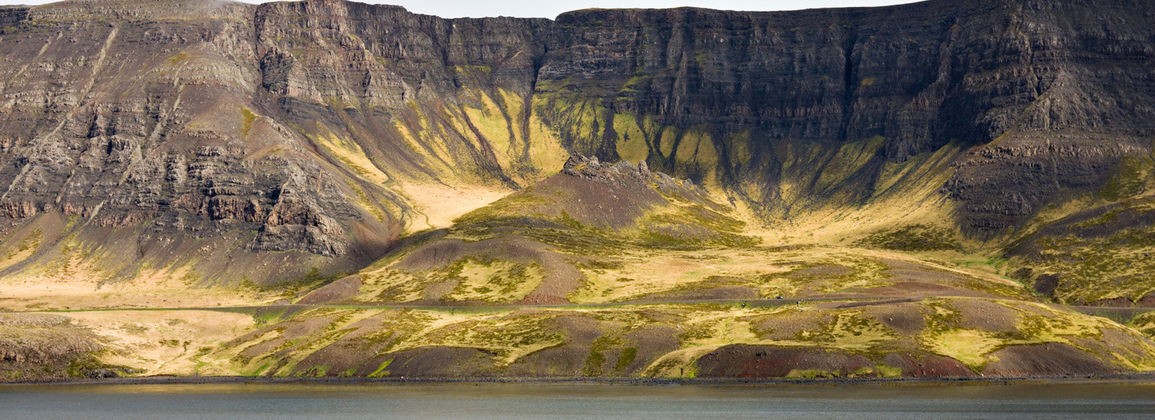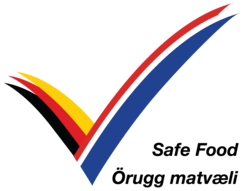The aim was to develop a Quality Index Method (QIM) scheme for fresh tilapia fillets and evaluate the scheme in a shelf life study. Farmed tilapia fillets were stored at 1 and −1°C for up to 20 days, and changes during storage were observed with sensory evaluation using the QIM scheme and General Descriptive Analysis (GDA), total viable counts (TVC), and hydrogen sulphide (H2S) producing bacteria. The maximum shelf life of fillets stored at1 and −1°C was determined with GDA and microbial counts as 16 and 19 days, respectively. A high correlation of R2 = 0.943 between Quality Index (QI) and storage time at 1C° was found to be 0.843 at −1°C. At the end of shelf life, the QI was 5.3 and 6.5 out of a maximum score of 15 for fillets stored at 1 and −1°C, respectively. Total viable counts and H2S-producing bacteria showed an increasing trend during storage time for both groups. At the end of shelf life, TVC was log 7 cfu/g in the flesh of both groups, with H2S producing bacteria constituting a higher proportion (log 6 cfu/g) of the total. The scheme was modified at the end of the study to better characterize deskinned farmed tilapia fillets.
Höfundur: admin

Íslenskir ferskfiskútflytjendur notast gjarna við kælimottur til að viðhalda lágu hitastigi ferskfiskafurða í flutningi, einkum flugflutningi. Kælimotturnar innihalda venjulega annað hvort ís eða þá einhvers konar gel, sem nauðsynlega inniheldur þannig efni að það megi komast í snertingu við fiskinn ef mottan rofnar, þ.e. innihald mottunnar er „food-grade“.
Á erlendum mörkuðum er úrval umræddra kælimotta allvítt en hér á landi eru stærstu söluaðilar kælimotta fyrir ferskan fisk Promens Tempra í Hafnarfirði og Ísgel á Blönduósi. Tempra framleiðir ísmottur, sem einungis innihalda vatn og Ísgel framleiðir gelmottur og hefur því verið haldið fram að mikill munur geti verið á kæligetu umræddra kælimotta. Til að athuga það rannsökuðu verkfræðinemarnir Hilmar Arnarson og Sandra Björg Helgadóttir nýlega bæði bræðslumark og kæligetu ísmotta frá Tempru og gelmotta frá Ísgel í námskeiðinu Fiskiðnaðartækni 2 við Háskóla Íslands.
Í tilrauninni komu þau fyrir hitasíritum innan í kælimottum, sem pakkað var í frauðplastkassa. Kössunum var komið fyrir í frysti í nokkra daga áður en þeir stóðu við stofuhita uns kælimotturnar voru að fullu þiðnaðar. Hitamælingarnar leiddu ekki í ljós marktækan mun á hvorki bræðslumarki ís- og kælimottanna (hann var u.þ.b. 0,0 +/- 0,3 °C) né kæligetu (hæfileika kælimottanna til að viðhalda lágu hitastigi matvöru), sjá mynd 1.
Nánari upplýsingar veitir Sigurjón Arason, prófessor við Háskóla Íslands og yfirverkfræðingur Matís.
 Mynd 1. Hitastig innan í ísmottum frá Promens Tempra og gelmottum frá Ísgel á meðan þíðingu stendur.
Mynd 1. Hitastig innan í ísmottum frá Promens Tempra og gelmottum frá Ísgel á meðan þíðingu stendur.
Kornafurðir og kornmarkaðir við norður Atlantshaf / Cereal Products And Markets In The Northern Periphery Region
Forverkefni um kornmarkaði og kornafurðir úr svæðisbundnu korni var unnið á tímabilinu september 2013 til mars 2014. Verkefnið var styrkt af Norður‐ slóðaáætluninni (Northern Periphery Promramme, NPP). Þátttakendur komu frá Íslandi, N‐Noregi, Færeyjum, Orkneyjum og Nýfundnalandi. Markmið verkefnis‐ ins var að: (1) Byggja upp samstarfsnet um kornrannsóknir. (2) Afla upplýsinga um kornframleiðslu og kornnýtingu á hverju svæði um sig og leita nýrra markaða og samstarfsaðila. (3) Leggja drög að umsókn um stórt kornverkefni. Þátttakendur greindu upplýsingar um kornframleiðslu og korninnflutning. Í ljós komu tækifæri til að láta innlenda framleiðslu koma í stað innflutnings. Kornmarkaðir og þróun markaða var tekin til skoðunar og mat var lagt á stærð markaða. Það ætti að vera mögulegt að auka innlenda framleiðslu á ýmsum kornvörum svo sem bökunarvörum, morgunkorni, pasta og áfengum drykkjum. Þátttökulöndin / svæðin eru á mismunadi stigi með tilliti til kornræktar og því þarf þróun kornvara að taka mið af aðstæðum.
A preparatory project scoping new markets and products from local cereals in several parts of the Northern Periphery Programme (NPP) area, was implemented between September 2013 and March 2014. The project included partners from the following regions: Iceland, N‐Norway, Faroe Islands, Orkney and Newfoundland. The project aim was to: (1) Build up a collaborative R&D network on cereals. (2) Review cereal production and utilization in each partner region and identify potential new markets and collaborators. (3) Develop a proposal for a main project. Partners quantified the domestic cereal production and import of cereals. Opportunities were found where imported cereals might be replaced by local products. Cereal markets and food trends were studied and the size of the market for cereal products was estimated. It is possible to increase the use of local cereals for production of many foods: bakery products, breakfast cerals, pastas and alcoholic beverages. The regions differ with regard to cereal production and development of cereal products should take the situation into account.
Skoða skýrslu

Trackwell og Matís eiga að baki langt og farsælt samstarf og eru verkefni eins og Framlegðarstjórinn, Afurðastjórinn og FisHmark dæmi um farsæl samstarfsverkefni fyrirtækjanna tveggja. Á Nýsköpunartorgi Samtaka Iðnaðarins, sem haldið var 23. og 24. maí sl., skrifuðu Jón Ingi Björnsson, framkvæmdastjóri Trackwell og Sveinn Margeirsson, forstjóri Matís, undir viljayfirlýsingu um enn nánara samstarf.
Í ofangreindum verkefnum, og fleirum til, hefur Tækniþróunarsjóður Rannís komið að fjármögnun og veitt verkefnunum fjárhagslegt brautargengi ásamt AVS sjóðnum.
Lykilafurð samstarfs fyrirtækjanna er og hefur verið aflaskráningarkerfi sem íslensk og erlend sjávarútvegsfyrirtæki nýta sér til aukinnar verðmætasköpunar, bættrar nýtingar og lágmörkunar umhverfisáhrifa af veiðum.
Ljóst er að þau verkefni sem TrackWell og Matís hafa unnið í sameiningu hafa skilað sjávarútvegsfyrirtækjum auknu gagnagegnsæi og þar með auðveldað stýringu veiða og vinnslu. Mikilvægt er að nýta þau gögn sem verða til í virðiskeðjunni á kerfisbundinn hátt til að hámarka framlegð og arðsemi greinarinnar í heild sinni.
Trackwell og Matís eru ánægð með núverandi samstarf, afurðir þess og tækifærin sem skapast hafa þegar tveir öflugir aðilar vinna saman. Ætlunin er að auka enn frekar samstarfið og mun aukin áhersla verða lögð á markaðsmál þar sem báðir aðilar tryggja að mikilvægi hvors annars í sameiginlegum verkefnum sé sýnilegt.

Nánari upplýsingar veitir Sveinn Margeirsson, forstjóri Matís.

Í dag var undirritaður samstarfssamningur Matís, Snæfellsbæjar, Grundarfjarðarbæjar og Stykkishólmsbæjar um stuðning við doktorsverkefni Birgis Arnar Smárasonar í umhverfis- og auðlindafræði við Háskóla Íslands. Birgir Örn vinnur á starfsstöð Matís á Akureyri.
 Frá undirskriftinni í dag. Sveinn Margeirsson, forstjóri Matís (fjærst), Lárus Ástmar Hannesson bæjarstjóriStykkishólmsbæjar, Björn Steinar Pálmason, bæjarstjóri Grundafjaðarbæjar og Kristinn Jónasson, bæjarstjóri Snæfellsbæjar.
Frá undirskriftinni í dag. Sveinn Margeirsson, forstjóri Matís (fjærst), Lárus Ástmar Hannesson bæjarstjóriStykkishólmsbæjar, Björn Steinar Pálmason, bæjarstjóri Grundafjaðarbæjar og Kristinn Jónasson, bæjarstjóri Snæfellsbæjar.
Verkefnið mun styðja við formennskuáætlun Íslands um nýtingu lífhagkerfisins, Nordbio (@Nordbio). Það gengur út á að greina van- eða ónýtta hráefnisstrauma og lífefni úr umhverfi Breiðafjarðar. Í því er m.a. stefnt að uppbyggingu nets hagaðila á Snæfellsnesi og samvinnu undir merkjum vistvænnar nýsköpunar.
Nánari upplýsingar veitir Sveinn Margeirsson, forstjóri Matís.

Ragnheiður Elín Árnadóttir, iðnaðar- og viðskiptaráðherra var rétt í þessu að veita verðlaun í keppninni EcoTrophelia Ísland sem Matís, ásamt Nýsköpunarmiðstöð Íslands, Háskóla Íslands og fjölmörgum stofnunum heima og erlendis standa að. Verðlaunin voru afhent á Nýsköpunartorgi Samtaka iðnaðarins sem haldið er í dag og á morgun í Háskólanum í Reykjavík.
EcoTrophelia Ísland er hluti af alþjóðlegri keppni og er vöruþróunarkeppni meðal háskólanemenda sem felst í því að þróa vistvæna matvöru. Markmið keppninnar er að minnka umhverfisáhrif frá íslenskri matvælaframleiðslu með því að skapa nýjar vistvænar mat- og drykkjarvörur. Þar er m.a. um að ræða notkun vannýttra hráefna, notkun nýrra og umhverfisvænna framleiðsluaðferða, umbúða eða flutningsmáta. Að keppninni standa Nýsköpunarmiðstoð Íslands, Matís og Samtök iðnaðarins í samstarfi við íslenska háskóla.
Tvö lið kepptu til úrslita í ár. Annað liðið skipa þær Brynja Einarsdóttir, Guðjóna Björk Þorbjarnardóttir og Hrefna Lind Einarsdóttir og voru þær með vöruna BEjuicy sem er frostþurrkaður grænmetissafi á duftformi. Hitt liðið skipa Christopher Melin og Páll Arnar Hauksson með vöruna Fjöru sem er þaramajónes. Svo fór að þaramajónes var valið sigurvegari Ecotrophelia Ísland að þessu sinni.

Ragnheiður Elín Árnadóttir, iðnaðar- og viðskiptaráðherra, afhendir EcoTrophelia Ísland 2014 verðlaunin.
Fjaran majónesið er skemmtileg nýjung á matvælamarkaði. Majónesið er unnið úr íslensku þangi og er þangið sólþurrkað á íslensku hrauni. Varan hentar grænmetisætum (e. vegans) jafnt sem öðrum sem áhuga hafa á því að bæta hollustuefnum í mataræði sitt. Nánari upplýsingar má finna á heimasíðu vörunnar, http://www.p.is/fjara/.
Nánari upplýsingar veitir Ragnheiður Héðinsdóttir, forstöðumaður matvælasviðs hjá Samtökum iðnaðarins og Guðjón Þorkelsson, sviðsstjóri hjá Matís.
Hefur þú áhuga á því að búa til vöru? Matarsmiðjur Matís eru kjörin vettvangur.

Nýsköpunartorgið verður haldið í Háskólanum í Reykjavík dagana 23. og 24 maí. Um er að ræða fagráðstefnu um starfsumhverfi og uppbyggingarferli nýsköpunarfyrirtækja og sýningu þar sem fyrirtæki og stofnanir kynna árangur í nýsköpun. Nýsköpunartorgið er haldið í tengslum við 20 ára afmæli Samtaka iðnaðarins og 10 ára afmæli Tækniþróunarsjóðs.
FAGRÁÐSTEFNA
Föstudaginn 23. maí kl. 8.45-17.00
Fagráðstefnan hefst með sameiginlegri dagskrá í Sólinni en síðan verða haldnar málstofur í sex stofum háskólans. Annars vegar eru þrjár línur um uppbyggingarferli nýsköpunarfyrirtækja þar sem fyrirtækjum er skipt í deildir eftir þroskastigi og hins vegar málstofur um tengda stoðþjónustu s.s. höfundarétt, einkaleyfi og staðla. Gestir ráðstefnunnar geta valið sér þá fyrirlestra sem mestan áhuga vekja.
Dagskrá:
Sameiginleg dagskrá kl. 8.45-10.00
- Ávarp – Ari Kristinn Jónsson, rektor HR
- Setning – Sigmundur Davíð Gunnlaugsson, forsætisráðherra
- Aukin framleiðni, verðmætasköpun og útflutningur – Guðrún Hafsteinsdóttir, formaður SI
- Fjárfestingar ríksins í nýsköpun – Tækniþróunarsjóður
- Starfs- og stoðkerfi nýsköpunarfyrirtækja – Salóme Guðmundsdóttir, Innovit Klak
Málstofur kl. 10.10-15.00
Málstofur 3. deildar: fyrirtæki sem velta 0-10 milljónum árlega
- Í startholunum – Fyrsta salan – Fyrsta þróunarverkefnið – Frumfjármögnun
Málstofur 2. deildar: fyrirtæki sem velta 10-100 milljónum árlega
- Vöruaðlögun – Framhaldsfjármögnun – Markaðsuppbygging – Þróun ferla og skipulags
Málstofur 1. deildar: fyrirtæki sem velta 100-1000 milljónum árlega
- Straumlínustjórnun- Uppskölun/Heildarlausnir – Vaxtarfjármögnun – Alþjóðavæðing
Málstofur þjónustu- og fagaðila
- CE-merking – Einkaleyfamál – Upplýsingaöryggi – Rafræn viðskipti – Erlent samstarf og styrkir – Tækniþróunarsjóður – Þjónusta NMÍ – Kauphöll Íslands – Þjónusta SI – Hlutafjármögnun NSA – Orkustjórnun fyrirtækja
Í hádegishléi verða veitingar í Sólinni. Ragnheiður Elín Árnadóttir, iðnaðarráðherra setur sýningu Nýsköpunartorgs og afhentar verða viðurkenningar í Ecotrophelia Iceland sem er keppni um vistvæna nýsköpun matvæla.
Að málstofum loknum afhendir Bjarni Benediktsson, fjármálaráðherra viðurkenningar Vaxtarsprotans. Boðið upp á léttar veitingar.
SKOÐA dagskrá
Spennandi NÝSKÖPUNARTORG fyrir alla fjölskylduna
Laugardaginn 24. maí kl. 11.00-17.00
Öllum þeim sem áhuga hafa á nýsköpun og tækni verður boðið á Nýsköpunartorgið. Um 70 nýsköpunarfyrirtæki og stofnanir kynna vörur og þjónustu en að auki verða margvíslegar uppákomur fyrir alla fjölskylduna, m.a.
- Kynningar fyrirtækja um tækifærin í tækni – Sjá DAGSKRÁ
- Pollapönk tekur lagið
- Kubbað með Mindstorm
- Spilað með Spilavinum
- Fjögur vinningslið GameCreator kynna nýja tölvuleiki
- Mælingar á ástandi húðarinnar í boði EGF húðvara
- Prófaðu að hjóla með heimsins léttasta hjólgaffli
- Hvernig verður rafmagn til?
- Nýsköpunarkeppni grunnskólanemenda
- Ekta eða fake? – Falsaðar vörur til sýnis
- Taktu þátt í nýsköpun á orðavegg Ský þar sem leitað er eftir íslenskun á enskum tölvuhugtökum
- og fleira skemmtilegt…
SKOÐA sýnendur
Frítt er inn á sýninguna.
Markmið Markmið Nýsköpunartorgsins er að skapa skýra mynd af árangri og uppbyggingu tækni- og hugverkaiðnaðarins og aðkomu stoðkerfisins og Tækniþróunarsjóðs og að þessari uppbyggingu auk þess að byggja upp sterka og jákvæða ímynd þessara fyrirtækja með því að sýna og segja frá nýsköpun í ólíkum fyrirtækjum.
Samtök iðnaðarins, Tækniþróunarsjóður, HR, Einkaleyfastofa og Ský og fleiri aðilar sem tengjast nýsköpunarumhverfinu á Íslandi standa fyrir Nýsköpunartorginu.
Nánari upplýsingar má finna á vefsvæði Samtak Iðnaðarins.

Matís, Promens, Thor Ice, Sjávarútvegsklasi Vestfjarða, Eimskip og Samskip eiga í samstarfi í verkefni sem snýr að flutningi ferskfiskafurða í kerum og kössum og eru að leita að tveimur nemendum í meistaranámi eða sem eru á leið í meistaranám.
Um tvö meistaraverkefni er að ræða og er mögulegt umfang þeirra beggja 30–60 ECTS (ein til tvær annir). Verkefnin henta einkum fyrir meistaranema í véla/iðnaðarverkfræði, matvæla- eða viðskiptafræði. AVS rannsóknasjóður í sjávarútvegi (www.avs.is) stendur straum af kostnaði vegna neðangreindra meistaraverkefna.
Verkefni 1-markmið
Hagrænn samanburður mismunandi pakkninga- og flutningsleiða fyrir ferskar fiskafurðir frá Íslandi til markaða í Evrópu og Ameríku. Greiningin tekur tillit til kostnaðar við mismunandi vinnslukælingaraðferðir, pökkunar, flutnings og gæðarýrnunar afurða. Nákvæmt mat á rúmmálsnýtingu kæligáma við flutning í kössum annars vegar og kerum hins vegar er hluti af verkefninu.
Verkefni 2-markmið
Áætla ákjósanlegt magn og gerð (salt- og íshlutfall) ískrapa í 340 L matvælakeri með tilraunum og/eða varmaflutningslíkanagerð með stöðuga fiskhitastigið –1,0 °C að markmiði. Þetta verður framkvæmt fyrir tvö möguleg tilfelli umhverfishita í gámaflutningi kera, þ.e. –0,5 °C og 3 °C og tvö möguleg upphafsfiskhitastig, þ.e. 0 °C og 5 °C. Felur einnig í sér að finna lágmarks magn og íshlutfall ískrapa, sem nota þarf í ker sem verður fyrir umtalsverðu hitaálagi (hærri umhverfishiti).
Verktími: maí 2014–apríl 2015
Nánari upplýsingar veita Sigurjón Arason, prófessor við HÍ og yfirverkfræðingur Matís (sigurjon.arason@matis.is) og dr. Björn Margeirsson, rannsóknastjóri Promens (bjorn.margeirsson@promens.com).

Samráðsþing Matvælastofnunar var haldið í gær en samráðsþingið er vettvangur Matvælastofnunar, eftirlitsaðila og annarra viðskiptavina stofnunarinnar til að styrkja samskipti sín á milli og koma sjónarmiðum á framfæri með gagnvirkum hætti.
Helga Gunnlaugsdóttir, fagstjóri hjá Matís fór á þinginu yfir öryggi afurða og fjallaði einnig um nýja rannsóknastofu í húsakynnum Matís en ítarlega er fjallað um opnun rannsóknastofunnar á fréttavef Matís.

Nánari upplýsingar um samráðsþingið má finna á vef Matvælastofnunar, www.mast.is, en nánari upplýsingar um nýju rannsóknastofuna og verkefnið Örugg matvæli má finna á vef Matís, www.matis.is.

Tilefnið var opnun glæsilegrar rannsóknastofu að Vínlandsleið 12 í Reykjavík en rannsóknastofan var sett upp vegna samstarfsverkefnisins Örugg matvæli.
Sjávarútvegs- og landbúnaðarráðherra, Sigurður Ingi Jóhannsson var viðstaddur opnunina ásamt sendiherra Þýskalands á Íslandi, Thomas Hermann Meister, en báðir héldu þeir stuttar ræður og opnuðu rannsóknastofuna formlega með borðaklippingum. Ágústa Guðmundsdóttir, sem situr í stjórn Matís, hélt einnig góða ræðu um mikilvægi rannsóknaaðstöðunnar fyrir almenning, fyrir íslenska matvælaframleiðslu og fyrir Matís og hvernig aðstaðan mun nýtast í m.a. námi í matvæla- og næringarfræði við háskóla Íslands.

Sjávarútvegs- og landbúnaðarráðherra, Sigurður
Ingi Jóhannsson og sendiherra Þýskalands á Íslandi,
Thomas Hermann Meister, opna aðstöðuna formlega.
Verkefninu Örugg matvæli er ætlað að tryggja matvælaöryggi og vernda íslenska neytendur. Verkefnið gerir íslenskum yfirvöldum, Matvælastofnun og heilbrigðiseftirliti sveitarfélaganna betur kleift að framfylgja löggjöf um matvælaöryggi og neytendavernd. Örugg matvæli er unnið í samvinnu Matís, Matvælastofnunar, Atvinnuvega- og nýsköpunarráðuneytisins, Federal Ministry of Food and Agriculture (BMEL), Federal Institute for Risk Assessment (BfR) og Lower Saxony State Office for Consumer Protection and Food Safety (LAVES) í Þýskalandi.
Með opnun rannsóknaaðstöðunnar og með bættum tækjabúnaði verður hægt að framkvæma mun fleiri mælingar innanlands en nú er s.s. mælingar á þörungaeitri í skelfiski og mælingu 300 varnarefna í matvælum í stað þeirra 60 sem nú eru mæld.
Verkefnið Örugg matvæli verður án vafa mikill stökkpallur fyrir íslenska neytendur, eftirlitsaðila og ekki hvað síst fyrir framleiðendur og söluaðila. Neytendur vilja nánari upplýsingar um efnin sem eru og eru ekki í matvælum sem þeir neyta og framleiðendur og söluaðilar vilja einnig fá þessar upplýsingar til að auka enn frekar traust neytenda á þeirra vörum.
Nánari upplýsingar veitir Helga Gunnlaugsdóttir, fagstjóri hjá Matís.

